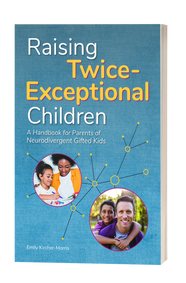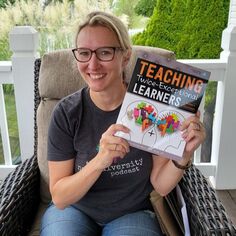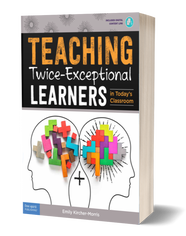Teaching Twice-Exceptional Learners in Today's ClassroomTwice-exceptional (2e) learners have often been misunderstood, disciplined, unchallenged, and left behind. Even as awareness of 2e learners has grown, educators are still in need of practical tools to recognize and support their twice-exceptional students. This book answers that need, providing teachers with accessible information about twice-exceptional diagnoses and suggested accommodations, modifications, and collaboration with other educational professionals.
Dedicated to the needs of all 2e learners, the first part of the book covers identifying and understanding 2e students, strength-based instruction, motivation and self-regulation, and executive functioning skills. The second part details how gifted students are affected by another diagnosis, including: specific learning disabilities, ADHD, autism, processing difficulties, anxiety-based diagnoses, and depression and other mood disorders. This book equips educators with information that will make it easier for them to advocate for their 2e students, including what they need to know about the individualized education plan (IEP) and Section 504 plan process. Special topics, such as gifted students with physical disabilities, students experiencing trauma, and gifted learners from diverse backgrounds, are also included. |
Raising Twice-Exceptional Children: A Handbook for Parents of Neurodivergent Gifted Kids

Just because a child is gifted doesn't mean they don't have other types of neurodivergence, like ADHD, autism, dyslexia, and more. Conversely, even children with one of these diagnoses can be cognitively gifted. Raising Twice-Exceptional Children provides you with a road map to understand the complex make-up of your "gifted-plus," or twice-exceptional, child or teen.
The book helps you understand your child's diagnosis, meet their social-emotional needs, build self-regulation skills and goal setting, and teach self-advocacy. It also shows you effective ways to collaborate with teachers and school staff, and it offers advice on finding strengths-based strategies that support development at home.
For too long, these kids have fallen through the cracks. This book provides key information on how to best support neurodivergent children by leveraging their strengths while supporting their struggles.
The book helps you understand your child's diagnosis, meet their social-emotional needs, build self-regulation skills and goal setting, and teach self-advocacy. It also shows you effective ways to collaborate with teachers and school staff, and it offers advice on finding strengths-based strategies that support development at home.
For too long, these kids have fallen through the cracks. This book provides key information on how to best support neurodivergent children by leveraging their strengths while supporting their struggles.

